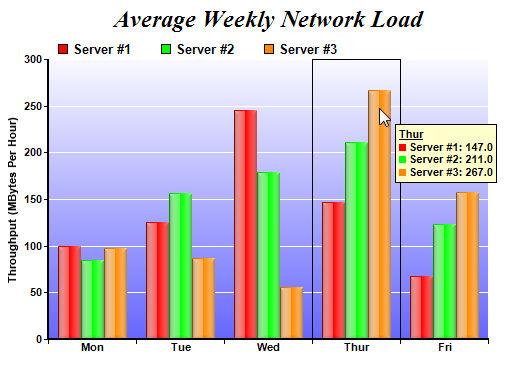#!/usr/bin/perl
# In the sample code, the ChartDirector for Perl module is assumed to be in "../lib"
use File::Basename;
use lib (dirname($0)."/../lib") =~ /(.*)/;
use perlchartdir;
# Get HTTP query parameters
use CGI;
my $query = new CGI;
#
# In this demo, the generated web page needs to load the "cdjcv.js" Javascript file and several GIF
# files. For ease of installation, we put these files in the same directory as this script. However,
# if this script is installed in a CGI only directory (such as cgi-bin), the web server would not
# allow the browser to access these non-CGI files.
#
# To get around this potential issue, a special load resource script is used to load these files.
# Instead of using:
#
# <SCRIPT SRC="cdjcv.js">
#
# we now use:
#
# <SCRIPT SRC="loadresource.pl?file=cdjcv.js">
#
# Similar methods are used to load the GIF files.
#
# If this script is not in a CGI only directory, you may replace the following loadResource string
# with an empty string "" to improve performance.
#
my $loadResource = "loadresource.pl?file=";
# The data for the bar chart
my $data0 = [100, 125, 245, 147, 67];
my $data1 = [85, 156, 179, 211, 123];
my $data2 = [97, 87, 56, 267, 157];
my $labels = ["Mon", "Tue", "Wed", "Thur", "Fri"];
# Create a XYChart object of size 540 x 375 pixels
my $c = new XYChart(540, 375);
# Add a title to the chart using 18pt Times Bold Italic font
$c->addTitle("Average Weekly Network Load", "timesbi.ttf", 18);
# Set the plotarea at (50, 55) and of 440 x 280 pixels in size. Use a vertical gradient color from
# light blue (f9f9ff) to blue (6666ff) as background. Set border and grid lines to white (ffffff).
$c->setPlotArea(50, 55, 440, 280, $c->linearGradientColor(0, 55, 0, 335, 0xf9f9ff, 0x6666ff), -1,
0xffffff, 0xffffff);
# Add a legend box at (50, 28) using horizontal layout. Use 10pt Arial Bold as font, with
# transparent background.
$c->addLegend(50, 28, 0, "arialbd.ttf", 10)->setBackground($perlchartdir::Transparent);
# Set the x axis labels
$c->xAxis()->setLabels($labels);
# Draw the ticks between label positions (instead of at label positions)
$c->xAxis()->setTickOffset(0.5);
# Set axis label style to 8pt Arial Bold
$c->xAxis()->setLabelStyle("arialbd.ttf", 8);
$c->yAxis()->setLabelStyle("arialbd.ttf", 8);
# Set axis line width to 2 pixels
$c->xAxis()->setWidth(2);
$c->yAxis()->setWidth(2);
# Add axis title
$c->yAxis()->setTitle("Throughput (MBytes Per Hour)");
# Add a multi-bar layer with 3 data sets
my $layer = $c->addBarLayer2($perlchartdir::Side);
$layer->addDataSet($data0, 0xff0000, "Server #1");
$layer->addDataSet($data1, 0x00ff00, "Server #2");
$layer->addDataSet($data2, 0xff8800, "Server #3");
# Set bar border to transparent. Use glass lighting effect with light direction from left.
$layer->setBorderColor($perlchartdir::Transparent, perlchartdir::glassEffect(
$perlchartdir::NormalGlare, $perlchartdir::Left));
# Configure the bars within a group to touch each others (no gap)
$layer->setBarGap(0.2, $perlchartdir::TouchBar);
# Create the WebChartViewer object
my $viewer = new WebChartViewer($query, "chart1");
# Output the chart
my $chartQuery = $c->makeTmpFile("/tmp/tmpcharts");
# Set the chart URL to the viewer
$viewer->setImageUrl("getchart.pl?img=/tmp/tmpcharts/".$chartQuery);
# Output Javascript chart model to the browser to support tracking cursor
$viewer->setChartModel($c->getJsChartModel());
print "Content-type: text/html\n\n";
print <<EndOfHTML
<!DOCTYPE html>
<html>
<head>
<title>Track Box with Floating Legend</title>
<script type="text/javascript" src="${loadResource}cdjcv.js"></script>
</head>
<body style="margin:5px 0px 0px 5px">
<script type="text/javascript">
//
// Use the window load event to set up the MouseMovePlotArea event handler
//
JsChartViewer.addEventListener(window, 'load', function() {
var viewer = JsChartViewer.get('@{[$viewer->getId()]}');
// Draw track cursor when mouse is moving over plotarea. Hide it when mouse leaves plot area.
viewer.attachHandler(["MouseMovePlotArea", "TouchStartPlotArea", "TouchMovePlotArea", "ChartMove"],
function(e) {
this.preventDefault(e); // Prevent the browser from using touch events for other actions
trackBoxLegend(viewer, viewer.getPlotAreaMouseX(), viewer.getPlotAreaMouseY());
viewer.setAutoHide("all", ["MouseOutPlotArea", "TouchEndPlotArea"]);
});
});
//
// Draw track box with legend
//
function trackBoxLegend(viewer, mouseX, mouseY)
{
// Remove all previously drawn tracking object
viewer.hideObj("all");
// The chart and its plot area
var c = viewer.getChart();
var plotArea = c.getPlotArea();
// Get the data x-value that is nearest to the mouse
var xValue = c.getNearestXValue(mouseX);
// Compute the position of the box. This example assumes a label based x-axis, in which the labeling spacing
// is one x-axis unit. So the left and right sides of the box is 0.5 unit from the central x-value.
var boxLeft = Math.min(c.getXCoor(xValue - 0.5), c.getXCoor(xValue + 0.5));
var boxWidth = Math.max(0, Math.abs(c.getXCoor(xValue + 0.5) - c.getXCoor(xValue - 0.5)) - 1);
var boxTop = plotArea.getTopY();
var boxHeight = Math.max(0, plotArea.getHeight() - 2);
// Draw the track box
viewer.showTextBox("trackBox", boxLeft, boxTop, JsChartViewer.TopLeft, "",
"width:" + boxWidth + "px;height:" + boxHeight + "px;border:solid 1px black;");
// Array to hold the legend entries
var legendEntries = [];
// Iterate through all layers to build the legend array
for (var i = 0; i < c.getLayerCount(); ++i)
{
var layer = c.getLayerByZ(i);
// The data array index of the x-value
var xIndex = layer.getXIndexOf(xValue);
// Iterate through all the data sets in the layer
for (var j = 0; j < layer.getDataSetCount(); ++j)
{
var dataSet = layer.getDataSetByZ(j);
// Build the legend entry, consist of a colored square box, the name and the data value.
var dataColor = dataSet.getDataColor();
var dataValue = dataSet.getValue(xIndex);
if ((dataValue != null) && (dataColor != null))
{
legendEntries.push("<nobr>" + viewer.htmlRect(7, 7, dataColor) + " " +
dataSet.getDataName() + ": " + dataValue.toPrecision(4) + "</nobr> ");
}
}
}
// Create the legend by joining the legend entries
if (legendEntries.length > 0)
{
var legend = "<u>" + c.xAxis().getFormattedLabel(xValue) + "</u><br />" + legendEntries.reverse().join("<br />");
// Display the legend at the bottom-right side of the mouse cursor
viewer.showTextBox("legend", mouseX + 16, mouseY + 16, JsChartViewer.TopLeft, legend,
"border:solid 1px black;background:#ffffcc;padding:3px;font:bold 11px Arial;-webkit-text-size-adjust:100%;");
}
}
</script>
<div style="font-size:18pt; font-family:verdana; font-weight:bold">
Track Box with Floating Legend
</div>
<hr style="border:solid 1px #000080" />
<div style="font-size:10pt; font-family:verdana; margin-bottom:1.5em">
<a href="viewsource.pl?file=$ENV{"SCRIPT_NAME"}">View Source Code</a>
</div>
<!-- ****** Here is the chart image ****** -->
@{[$viewer->renderHTML()]}
</body>
</html>
EndOfHTML
; |
